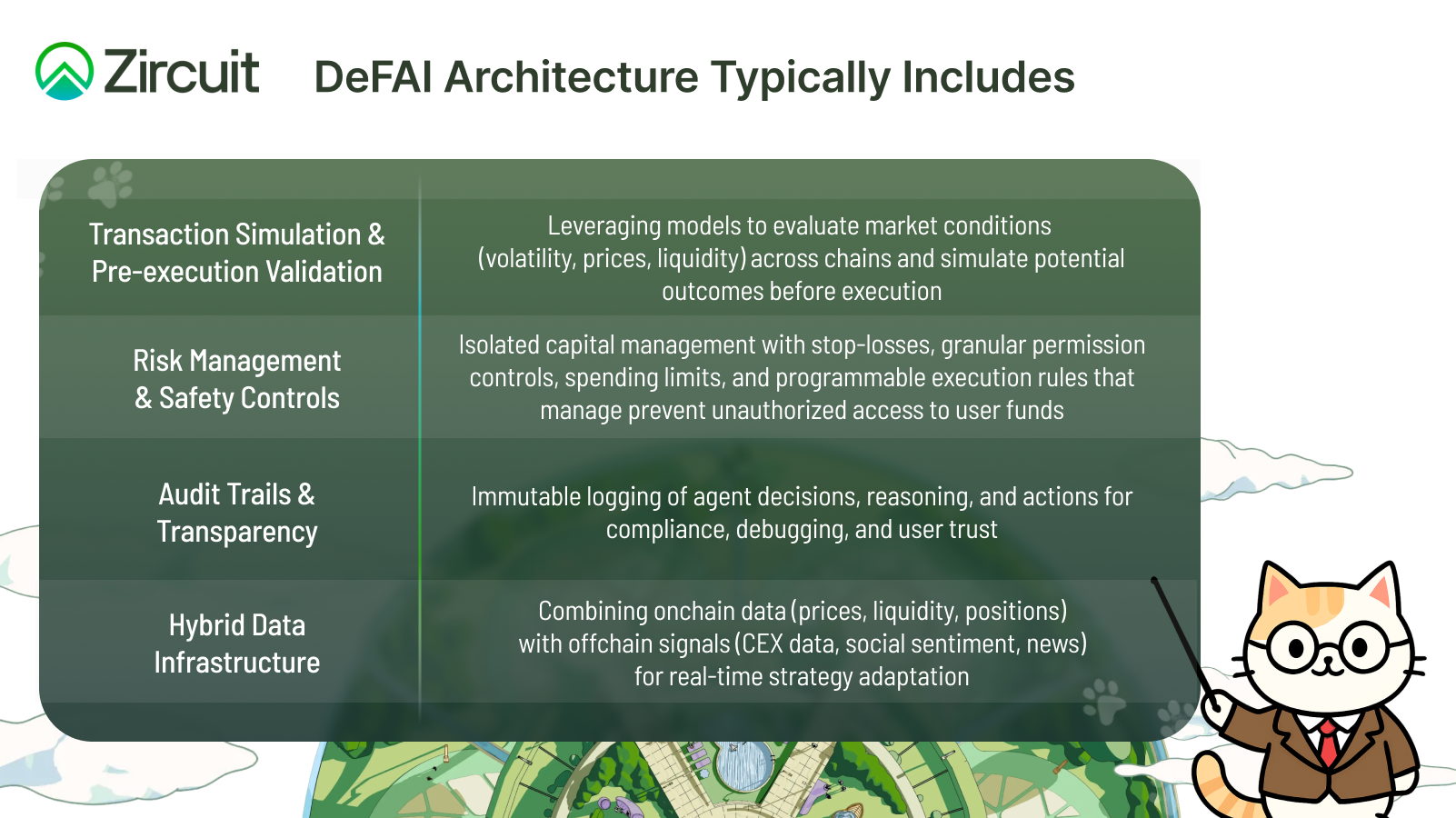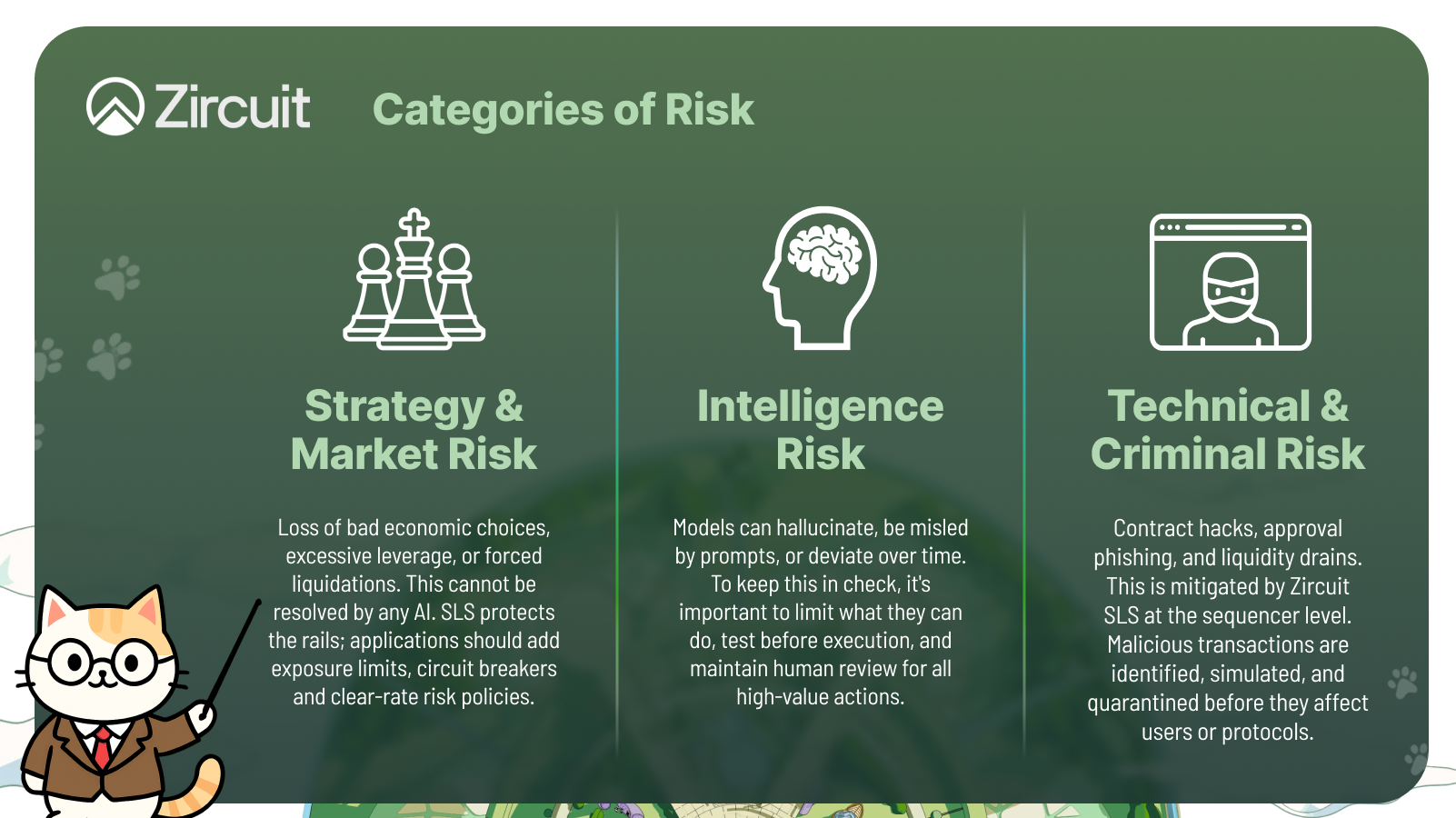.png)
In the ongoing evolution of decentralized finance, a new paradigm is starting to take shape, one that blends the raw composability of DeFi with the decision making intelligence of machine learning. Welcome to DeFAI, a model where autonomous agents and machine learning aligns with blockchain principles to deliver a financial experience that is faster, safer, and easier to use.
While DeFi paved the way with permissionless innovation, DeFAI aims to redefine its meta by automating on chain execution, optimizing strategies, and abstracting complexity. The goal is to move the user from micromanaging protocols to simply stating intentions and letting intelligent systems handle the rest.
DeFAI stands for Decentralized Finance plus Artificial Intelligence, and it is more than a technical fusion. It is a vision for how agents can act on behalf of users, automating everything from liquidity routing to portfolio rebalancing under strict limits. Instead of hopping across many dApps, the user states an objective like “swap asset A for B on the best route” and the agent executes the plan.
An intent-based experience replaces repetitive switching between protocols. Autonomous agents translate goals into precise transactions that are simulated, optimized, and confirmed in real time.
2025 is shaping up to be the turning point for smarter DeFi. The key pieces are coming together: progress in onchain automation, account abstraction, modular vaults, and L2 scalability. These advances are driving a market shift toward secure automation, the core trait of DeFAI. Developers are already exploring systems where strategies are planned and simulated by models but executed with kill switches and allowlists. For users, the experience becomes fluid: fewer decisions, clearer outcomes, safer interactions.
If DeFi is about composability, DeFAI is about orchestration.
DeFAI applications are built around the interaction of intelligent agents with modular and composable infrastructure. These agents act as the decision and execution layer, continuously planning and adjusting strategies based on evolving onchain data, news, oracle inputs, and predefined policies. Their job is not just automation. It is contextual decision making under strict constraints.
What separates DeFAI from early DeFi bots is a well tuned architecture. But above that, the agents themselves operate within clear limits, protected by programmable safeguards: simulate before executing, cap size and slippage, apply rate limiting, and require a co-sign for sensitive operations. Execution is not only reactive, it is managed by various safeguards.

As we can see, although the architecture varies, the intent is consistent. DeFAI systems aim to empower autonomous agents that can execute independently without compromising user safety or control.
YieldSeeker is a great example of how defi works in practice, the project gives each user a personal agent that constantly scans top protocols and reallocates idle USDC into risk-adjusted opportunities. It considers APY, reward incentives, protocol risk, and liquidity depth, and it runs as a Base mini app with a simple, conversational flow. The project has been highlighted by ETHGlobal’s Spotlight program and even featured by the official Ethereum account signals of how agent-driven DeFAI is gaining real traction.
Projects such as Griffain, Orbit, and Aixbt have already begun to prototype these architectures. Yet despite technical viability, they remain in early stages. What limits adoption is not execution capacity but operational risk, economic safety, and the predictability of user experience and security is exactly the challenge that Zircuit addresses at the protocol level with mastery.
Beyond yield optimization, DeFAI is also transforming how users interact with their assets through intelligent wallets. Projects like Armor Wallet bring AI directly into the wallet experience, offering real-time risk analysis, transaction simulation, and automated security checks before execution. This represents a shift from wallets as passive storage to wallets as active guardians, where AI agents continuously monitor for threats, optimize gas fees, and provide contextual insights on every interaction.
DeFAI’s still leveling up. First we had basic bots that fired preset orders when certain conditions hit. The next wave brings agents that test moves ahead of time, track live market shifts, and decide using real numbers. The projects mentioned show that technical viability exists, but adoption runs into three distinct categories of risk that must be handled differently, as we can see in the example:

Secure DeFAI doesn't rely on a single trick. It depends on the right combination of strong infrastructure, clear application boundaries, and responsible product design. Zircuit provides the foundation. Builders do the rest, allowing them to build intelligent systems on top of it.
The promise of DeFAI does not end with protocol design or agent theory. It proves itself or fails in production. For automation to work safely, the underlying blockchain must meet demands that go far beyond what traditional Layer 2 networks offer. This includes real time threat prevention, smooth agent execution, and programmable safety at the infrastructure level, this is where Zircuit stands apart.
The Trading Engine represents a cornerstone of our commitment to building robust infrastructure for DeFAI operations. As AI agents and automated trading systems require seamless, efficient cross-chain execution, the Trading Engine aggregates liquidity across multiple blockchain networks and bridge protocols to deliver optimal trading rates without compromising on security or custody. The engine's multi-protocol integration ensures AI agents can access the deepest liquidity pools while its best quote aggregation automatically identifies the most favorable rates across all connected protocols.
By supporting gasless transactions through EIP712 signatures and enabling direct wallet execution, we remove friction from automated trading workflows, allowing DeFAI applications to operate at scale. This infrastructure is purpose-built to handle the high-frequency, multi-chain operations that modern AI trading systems demand, with transparent fee structures and universal token support that make it an ideal foundation for the next generation of autonomous financial agents. More information on how to use the Trading Engine can be found here.
The unique Zircuit contribution to the DeFi + machine learning landscape. Unlike common L2 networks that only order and batch transactions passively, the Zircuit sequencer actively monitors and filters the mempool, identifying and neutralizing malicious transactions before they are even included. When agents have autonomy over capital, even a single exploit can trigger cascading failures. SLS breaks that chain before it starts.
Developers building DeFAI systems, whether intent routers, portfolio managers, or liquidity optimizers, benefit from a base layer that is aligned with their needs.
Zircuit provides the programmable trust that DeFAI needs to scale, identifying attack patterns, simulating transactions, and quarantining malicious attempts before they are finalized.
The DeFAI revolution is happening now, and Zircuit is positioned as the base layer where this transformation can happen safely. If you are a developer exploring intent routers, autonomous vaults, yield optimizers, and more, SLS offers protocol level protection that enables innovation without compromising safety.
For partners and integrators such as wallets, DEXs, and data providers, Zircuit represents an opportunity to build DeFAI experiences that users can trust. The infrastructure is ready, the guardrails are active, the ecosystem is growing.
Explore the Zircuit documentation, join our Grants Program with DeFAI ideas, or connect with the team to discuss integrations and use cases. The DeFi meta is changing, and this is your opportunity to be part of this revolution.
See you next time,
The Zircuit Team 💚